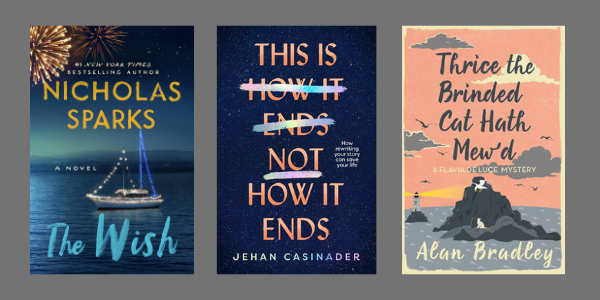After reading a previous Nicholas Spark's which felt like a self-therapy book, I wasn't sure whether I wanted to read this one in case it was along the same vein. I have to say, I'm glad I took the leap. This is the Nicholas Sparks of old - the one who writes emotional stories of love and loss ala "Message in a Bottle". I was prepared to put it down and spend only a portion of my weekend reading, but I ended up reading it one sitting. Who needs lunch on time anyway? This is the kind of book you want to curl up with when no one is around, book and snacks in hand. I found it worth my time. I will warn you, you may need tissues!
-Rachel
'This is not how it ends: how rewriting your story can save your life' by Jehan Casinader
Having been lucky enough to hear him speak at the LIANZA conference, I thought I'd get back into grown-up reading with Jehan's book. I was not disappointed. His journalistic career translates well to his writing style in this book. He includes vignettes that perfectly illustrate his points and while I'd describe it as quick and easy to read (I did it in one sitting), the messages stay with you and provide a lot of food for thought. Highly recommend it!
-Heather
'Thrice the Brindled Cat Hath Mew’d' by Alan Bradley
This is the ninth book in the Flavia De Luce Mysteries series by Alan Bradley and follows the misadventures of 12 year old amateur detective and chemistry enthusiast Flavia De Luce.
The book is told in Mr. Bradley’s signature style combining whimsy and cleverness in equal measure and moves at a steady pace through a fairly uncomplicated plot. The central character is precocious and self-possessed to a fault, and while sympathetic enough, I’m not sure I warmed to her quite so much as perhaps the author may’ve been expecting me to. In fact, the chief issue I took to the book is that author seems to take entirely too much for granted.
Perhaps it’s because I’ve jumped into a series too far along, but I found that not enough care was taken to set scenes or describe characters, such that my imagination was constantly wavering between different possibilities with regards to the appearance and general arrangement of things and people in each setting. Therefore, and even though the plot of the book is fairly self contained, I would probably recommend reading this series from the first instalment onwards.
The main character’s home of Buckshaw, for example, is described as an old manor house but is barely described beyond that point. As a result, I have no mental picture of the house whatsoever despite it being a fairly central location. Instead, a lot of the exposition is taken up with quirky observations of a frivolous nature, which lend the book a lot of personality, and some charm, admittedly, but colour is added, thereby, to scenes with little in the way of a proper outline.
My final objection to the book is just a personal objection I have to genre fiction in general, which is that as this is a murder mystery, the plot is stretched around a too-familiar framework, and feels like it’s ‘going through the motions’, powerless to give the reader a sense of adventure or discovery.
I would recommend giving this book a try for fans of the series and the genre in general, as it is stylishly-written and generally entertaining and inoffensive.
-Josh
Find more great reading recommendations on our Books and Reading page

